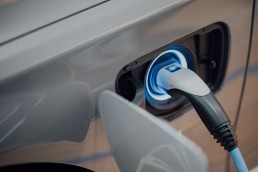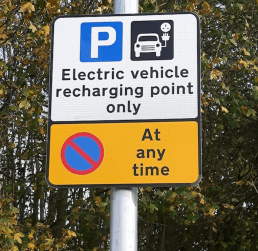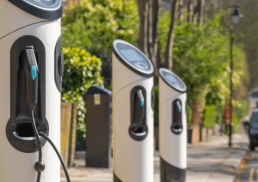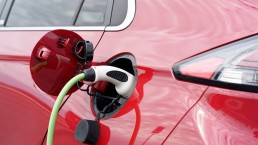RECHARGE UK calls for new government to put renewed focus on skills
Electric vehicle (EV) trade group RECHARGE UK has called on the new government to put a renewed focus on skills.
Specifically, the group wants to see radical changes to skills and training courses across the UK.
This builds upon recommendations set out in the group’s report ‘Harnessing the skills opportunities of a recharged electric vehicle sector’ which explores how the UK can equip its workforce for the exciting opportunities emerging in the EV sector.
RECHARGE UK is the EV arm of the REA (Association for Renewable Energy and Clean Technology). The report was produced in association with Curzon Consulting.
Ahead of the General Election, Labour said it would provide Technical Excellence Colleges which would work with businesses, trade unions and local government to provide young people with better job opportunities and the highly trained workforce local communities need in this changing world.
The government has now confirmed that it will establish a body to be known as Skills England, and reform the Apprenticeship Levy.
A briefing document states that Skills England will ‘bring together businesses, providers, unions, mayoral combined authorities and government to ensure we have the highly trained workforce that England needs’.
RECHARGE UK’s report calls for Centres of Excellence for Net Zero Skills which would see local employers sponsor courses at these sites, located in existing colleges and schools in the heart of communities. Providing additional funding, and resources to these education establishments. It would provide a clear and obvious pathway for post 19 education, where college and university graduates could specialise in net zero skills such as chargepoint installation and maintenance.
The REA’s Transport Policy Manager Matthew Adams said
We welcome the engagement Labour had with our skills report when they were in opposition. I hope that we can continue to have a strong relationship to deliver the change the industry needs to accelerate the deployment of charging infrastructure across the UK. The launch this week of Skills England prioritising the skills the UK needs going forward is a good start and I hope takes on some of our recommendations and recognises the challenges for each part of the EV sector from manufacturers, to installers and charge point operators (CPOs) to software providers and local authorities and technicians.
The Climate Change Committee (CCC) estimate that by 2030, between 80,000- 100,000 jobs[1] could be created by electric vehicle and battery manufacturing in the UK. Meanwhile we are seeing a decline in the number of people qualified to operate and install electrical machinery. Since 2018 the number of people with electro technical skills has fallen by 19% from 342,000 in 2018/19 to 276,000 ± 10,000 in 2023[2].
Research by Curzon Consulting for RECHARGE UK’s report offers a unique insight into current and future recruitment concerns by charge point operators (CPOs). Of those CPOs interviewed by Curzon, 75% of CPOs expressed the view that the current skills gap was “significant” to “very significant”. Recruitment is predominantly from outside the EV industry and 25% of CPOs stated that it took them two months to fill vacancies, with 42% experiencing a lag of three months or longer to fill EV electrician roles.
Almost 40% of those surveyed also said that skills shortages were impacted by Geography. This highlights that a full national strategy like a Centres for Excellence programme could be beneficial in addressing the growing demand for electrical skills across the country.
Most pressingly all CPOs surveyed said that demand for electricians would rise significantly in future and 48% said that demand would rise beyond what the current workforce could support.
Natalia Sokolova, Partner, Curzon Consulting, commented:
With the establishment of Skills England and the reform of the Apprenticeship Levy, we are setting the stage to bring together businesses, providers, unions, and government bodies to build a highly trained workforce. Our research evidences that we must go even further to create Centres of Excellence for Net Zero Skills. The time to act is now
The report can be viewed here – https://www.r-e-a.net/wp-content/uploads/2024/04/Harnessing_the_skills_Report-D2_Low-Res.pdf
[1] https://www.theccc.org.uk/wp-content/uploads/2023/05/CCC-A-Net-Zero-Workforce-Web.pdf
[2] https://www.the-esp.org.uk/wp-content/uploads/2023/06/TESP-2023-LMI-Refresh-879.pdf
CONTACT US TO FIND OUT HOW WE CAN HELP
Can charging supply keep pace with electric vehicle demand?
Net-zero carbon emissions by 2050…
Electric vehicles (EVs) are increasingly heralded by nations across the globe as a vital part of the net-zero transition to reduce emissions, and the key technology for decarbonising transportation, which accounts for 13% of emissions globally. But whilst vehicle sales have been booming in recent years, the installation of charging networks that underpin EV usage are trailing dangerously behind. The extent of this lag is particularly concerning in the United Kingdom (UK) where it poses a fundamental threat not just to the continued growth of the EV market, which by the end of 2023 is projected to be worth £16bn, but it threatens any plans for the UK to reach net zero carbon emissions by 2050.
A global EV boom driven by three central influences
Such has been the drive to increase the uptake of EVs, that global sales of Battery EVs (BEVs) and Plug-In Hybrid EVs (PHEV) doubled in 2021 from the previous year, and 2022 saw a +55% increase in global EV sales over ‘21. The registration of 10.5 million new vehicles in ’22 was despite component supply chain shortages and disruptions from the war in Ukraine that hampered output. With approximately 27 million EVs on the road today, they now account for a global market share of 13% of vehicles on the road.
What is clear is that as global consumers increasingly align their climate-driven values with vehicle purchasing, the number of EVs on the road will continue to rise exponentially. This is an ‘EV boom’ that has been accelerated by a combination of three central influences:
- Sustained governmental policy support, in the form of subsidies and incentives, pledges to phase out internal combustion engines (ICEs), and lofty electrification targets
- The rise in the availability and performance of EV models, which now gives consumers five times as many to choose from than in 2015
- Electrification of fleets by car manufacturers, in a race to meet rising consumer demand.

Showcasing the innovations and ideas behind EV market growth
The annual London EV show and conference, held at the end of November ‘22, is a platform where stakeholders from all three market influences gather to showcase the innovations and ideas that are spearheading the UK EV transition. With representation from the entire value chain, this year’s event included collaborations between government representatives, fleet management, charging systems & solutions providers, battery technology providers, major car manufacturers, and other influential stakeholders.
Attending the show provided me with a ‘peak-under-the-bonnet’ of the UK EV market and shed light on some of the key trends emerging in 2023 and beyond. Conference talks included those from industry leaders and leading research centres, amongst the latest vehicle innovations being showcased. These talks had one key common theme – that whilst a marketplace as dynamic as EVs offers great opportunity, commercially and in tackling climate change, capitalising effectively on these opportunities over the next few years will be fraught with challenge for the UK.
UK charging infrastructure is struggling to keep pace with the EV growth
The London EV show highlighted just how much the UK EV market has expanded in recent years in line with global growth, notching up an impressive 92% increase in EV registrations between January ‘21 and January ‘22.
UK charging, however, is still in its infancy relative to the vehicles it powers, and comparatively lags behind. There is a growing disparity between the growth rates of EV sales in the UK and charge point installations. This divergence threatens to impede the UK from meeting climate-goals set by the government and derail the feasibility of the UK’s ban on internal combustion engines (ICEs) that looms in 2030.

When you compare the absolute number of public charge point installations the UK needs to support the proposed transition, with current figures, it is clear there is still a long way to go. If the government’s 2022 charging infrastructure strategy successfully meets its ambition, by 2030 there should be over 300,000 public chargers installed nationwide. In comparison, as of January ‘23, there were cumulatively just 38,000 public charge points available across the UK.
More importantly, though, is considering the pace of charger installations relative to new EV registrations – which is slowing owing to the continued acceleration of new EV registrations. Since January ‘20, the cumulative number of EVs in the UK has increased 3.8X, whereas the number of charge points has increased just 2.6X. This increasing disparity is made ever clearer by the change in the UK’s EV-to-charge point ratio – a measure which helps assess the suitability of a nation’s charging network to support its vehicle’s needs.
As a benchmark, the Alternative Fuel Infrastructure Directive (AFID), an EU policy which regulates the deployment of public chargers, recommends a ratio of 10 EVs per public charge point for EU member states.
In 2016, the UK had a healthy ratio of approximately 8 EVs per charge point. Comparatively, the UK now has the 9th worst global ratio of 21 EVs per public charge point. There are evidently key lessons to be learned from the likes of South Korea, the global leader which boasts a ratio of just 2.6.
Unlocking mass adoption with public charging infrastructure
The vehicle-to-charger gap poses a fundamental problem to the mass adoption of EVs in the UK, for two main reasons. Firstly, on average, 30% of UK households lack off-street parking for residential charging. This figure rises to around 40% across major UK cities, and as high as 50% in London. These households will therefore have to rely on the public charging network – either off-street slow, charging, or nearby fast/rapid charging hubs – to charge their vehicles at home.
This scenario works, provided there are enough charge points to accommodate users. However, too few chargers pose a major barrier for drivers switching over from ICEs, who will view EVs as impractical until there is somewhere suitably convenient to charge them.
When Which? surveyed 1.5k electric car owners, nearly half said that their nearest public chargers were over a 20-minute walk away.
Not exactly convenient.

The logic is the same looking across the UK’s charging network for longer journeys. For true mass adoption, there needs to be enough charge points to make charging your vehicle battery as convenient as filling up with fuel currently.
Speak to any EV owner in the UK, however, and they will tell you of the growing issues around public charging: long queues, a myriad of payment systems and apps to contend with for different charge-point-operators, and chargers which simply don’t work (experienced by 4 in 10 customers of public EV chargers).
This is not conducive to convincing the masses to switch from ICE vehicles to the more sustainable option of electric.
These issues with the charging infrastructure will continue to exacerbate as drivers become increasingly reliant on public chargers, versus at home or work, the more that make the switch to EVs. The UK urgently needs to accelerate its plans for large-scale installations across the public charging network, which is so far failing to deliver the c.100 installations per day needed until 2030 – last month (Jan ’23) just 28 charging devices were installed per day. A large-scale programme such as this requires a unified drive from all stakeholders.
As demand and supply continue to fall out of balance, this situation presents opportunities for private investment in the expansion of the charging networks. The current EV charge point operator market is highly fragmented and lacks a ‘gold-standard’ of consumer vehicle charging. There is a clear market need that so far appears unfulfilled in both availability and quality.
Whilst there are a multitude of other challenges that must be addressed, such as ensuring a sufficient supply of electricity to meet charging demands, each of these challenges offers their own commercial opportunities.
For those considering entering or expanding within the space, now is the time to answer the key strategic questions – what is the ‘Size of the Prize’ available? Which of the current barriers-to-adoption offer the greatest opportunities if addressed effectively, and how can that value be harnessed?
Milo Eadie
Milo is a strategist and transformation consultant with experience across capital projects, electric vehicle fleets and charging infrastructure, and product development. He began his career as a design engineer in the nuclear industry, where he consulted on the UK's fleet of reactors.
His expertise includes business strategy, data-driven decision making, productivity optimisation, and applied innovation and implementation. He is passionate about combining these skills to support clients in achieving their Net-Zero ambitions.
Milo is a Master of Engineering (MEng, Hons) from the UK’s leading General Engineering course at the University of Bristol, where he gained specialisms in Sustainability, Project Management and Entrepreneurship.
CONTACT US TO FIND OUT HOW WE CAN HELP
Carbon net zero consensus vs the circular economy
Two core concepts behind carbon net-zero (CN0) are carbon reduction, which focuses on lowering negative greenhouse gas (GHG) emissions, and carbon offsetting, where negative emissions are counterbalanced through activity and investments that theoretically net-off their impact.
Policy and public consensus leave the impression that achieving ‘carbon neutrality’ or CN0 through this reduction and offsetting is the one (or two) stop-shop solution to addressing the world’s climate change and sustainability challenges. Perhaps a bit more constructive challenge to this consensus is required.
Up in the trees
The majority of carbon offsetting is conducted through reforestation or afforestation. There are other more esoteric activities such as targeted investments in developing nations that facilitate reduced GHG emissions, e.g. gifting fuel-efficient stoves to specific communities. However, at present there is particularly limited agreement on the timing of offsetting activities; organisations can theoretically report outcomes years ahead of their implementation.
About the author

Phil Hanson
More about the authorA guessing-game
Whilst meaningful calculations of CO2e emissions are plausible, arguably the calculation of carbon offset is a guessing game. Using reforestation and afforestation as examples: The lack of scientific consensus on the calculation of carbon capture, the finite lifetime of trees, failure to account for existing flora being displaced by trees being planted, the global-warming impact of light absorption by dark forests (especially in previously white, tundra regions) and the insulating impact of organic aerosols released by trees all serve as strong challenges to the generally accepted carbon-capture benefits.
The organisations promoting empirically precise carbon offsetting activities are inevitably motivated to deliver the most significant carbon-capture for a given cost, often driving them to plant fast-growing trees to generate the speediest carbon sinks. Studies, however, have shown that rapid tree growth directly correlates with short life-span, after which the dead tree is either decomposed naturally or burned. This releases the “captured” CO2 and accelerates the point at which carbon capture is permanently reversed. Careless tree-species selection creates further challenges around habitat preservation, for both flora and fauna, with major knock-on consequences for local ecosystems.
Even more fundamentally, the term CO2e may acknowledge the net warming effects of GHGs, but when it comes to carbon capture, it risks oversimplification. Photosynthesis captures CO2, but the remaining GHG groups including nitrous oxides, hydrofluorocarbons and chlorofluorocarbons are not part of the equation; they continue being generated and released unabated and ignored.
It’s all about timing
There are various accounting methods for assessing the impact of timing with respect to money: Discounted Cash Flow, Net Present Value and Internal Rate of Return, are calculations that recognise the importance of timing in financial decision-making. No such calculations exist for carbon offset: Organisations can produce GHGs today, and have a ten-year-plus plan for when these will be offset, without addressing the damage or reduced benefit of the delay. The urgency of action on sustainability is unquestionable, acknowledged but still not fully understood.
Regressive macro-behaviours
The prevalence of the CN0, Sustainability and ESG agenda certainly highlights a widely shared intention. However, albeit perhaps being deliberately extreme in reference points, some of the large-scale actions being marketed highlight branding exercises that deflect from the critical need for more fundamental change in our approach.
Take the whole concept of carbon credits as an example? It can be humorously (and dramatically) argued that these are reminiscent of the medieval Catholic practice of selling “indulgences”; a financial penalty to reduce the religious penance required by heaven for forgiveness. The wealthier you were, the lesser the repercussions for sinning!
However, their regressive macro-behaviours are no laughing matter. Reforestation for example typically takes place ‘behind closed-doors’ and this can have disastrous results. Since 2009, the Kenya Forest Service, backed by EU funding for reforestation, has been forcibly removing and dispossessing the Sengwer people of the Embobut Forest, burning more than 1500 homes in the process, and killing one Sengwer man. This humanitarian disaster, highlights just one facet of the overlooked, problematic underbelly of our approach to CN0.
The BBC and Greenpeace have run articles highlighting the level of waste being exported to Turkey, with estimates of 40% of UK plastic ending up there. In theory, this plastic is exported to be recycled, but the reality is that once those responsible have pocketed their payment, it is simply dumped. Simplistic recycling targets, and an acceptance of devolving accountability is at the root cause of these issues: The National Audit Office was damning in its findings stating in July 2018 that “[The UK’s recycling system] appears to have evolved into a comfortable way for government to meet targets without facing up to the underlying recycling issues. The government has no evidence that the system has encouraged companies to minimise packaging or make it easy to recycle. And it relies on exporting materials to other parts of the world without adequate checks to ensure this material is actually recycled, and without consideration of whether other countries will continue to accept it in the long term.”

Carbon offsetting opportunities are a finite resource
There is a limit to how much reforestation and afforestation can be conducted, both in terms of absolute capacity, or more challengingly, due to financial constraints. The largest and longest-lived type of commercially grown fauna is fruit trees (the largest major group being cherry trees) which typically grow no more than 15m tall, whereas as an example, most pine species consistently grow to 50m or more. Broadly speaking, the taller the tree, the denser the carbon capture for a given area. What this means is that optimal carbon-sink solutions have severely limited meaningful commercial benefit so the land must be procured for offsetting projects, and maintained at cost. At present, there are large swathes of suitable low-price land available, but as these options are exhausted by initial offsetting ventures future projects will have to procure land with commercial uses at much higher costs. Developed nations will likely purchase the majority if not all of the cheap land, leaving developing nations with few or no options available.
Used cooking oil is commonly re-purposed in the UK, burned as biodiesel in lorries, which once again, in isolation is a positive step. However, such is that the appetite for cooking oil derived biodiesel in the UK, that businesses have begun importing it from overseas. Burning marine diesel to transport cooking oil to be burned as biodiesel (which still emits GHGs) all to save on lorry diesel usage? This has a net detrimental environmental effect compared to burning biodiesel at or near its origin and raises obvious questions.
CN0: A single, over-simplified metric
Putting aside carbon off-setting practices, measuring CO2 emissions as the sole metric for success in the sustainability battle means that other negative consequences become fair game. Resource depletion, habitat destruction, loss of biodiversity, water pollution, water poverty and human suffering at times go unchecked. There is particular cause for concern around “green” technologies with a focus on energy generation and energy storage.
- Dependence on cobalt: At present, the highest energy-density commercially available batteries are lithium-ion (Li+) with cobalt-based cathodes and they form the mainstay of almost all consumer electronics where battery size and weight are critical selling points like phones and laptops. More than 55% of the world’s cobalt is mined in DR Congo, where Amnesty International estimate 40,000 child workers are at risk of contact dermatitis, Hard Metal Lung Disease, lethal mine collapses, atrocious working conditions and modern-day slavery.
- Lithium remains a problem: Manufacturers of larger applications of Li+ batteries such as battery-electric cars, have more recently been moving away from cobalt cathodes, such as Tesla in September 2020, but the lithium remains problematic. Lithium is found in three forms in the earth’s crust; in solution (brine) and two mineral formats (pegmatite and sedimentary). Lithium brine forms the majority of global reserves, and is predominantly found in low purity form of 4-6% in deep aquifers (subterranean water reserves) often underneath unique salt-flat habitats. Lithium brine is pumped onto vast plastic sheets to evaporate the water and leave behind lithium salt deposits. Extraction of mineral forms means mining, whilst purification requires sulphuric acid, releasing atmospheric CO2. Modelling by LUT and Augsburg universities suggest earth will exhaust its lithium reserves between 2040 and 2100 dependent upon battery technologies, battery electric vehicle (BEV) manufacturing, lithium recycling and global population variables. This modelling assumes the appetite to destroy virtually all of the world’s largest salt-flat ecosystems.
- Water: Water vapour is part of a positive environmental and atmospheric feedback loop. Unfortunately, due to some of the aforementioned CN0 related activities there are some serious ramifications for water on the horizon. Making full use of global lithium reserves requires (along with rock extraction) removal and evaporation of subterranean lithium brine. Much of this supply is in the form of non–meteoric aquifers; meaning they are not replenished during the course of the hydrologic (water) cycle, instead consisting purely of water formed by geological events early in the earth’s history, from evaporated seas and volcanic activity. These supplies are not renewable. Further still, this removal and evaporation causes the water tables to drop in the associated surrounding areas which has a resulting detrimental effect on wildlife, farming, etc. Lithium brine is typically found beneath evaporated sea-beds which are almost exclusively located in deserts with no viable alternative water source.
- Solar power comes at a price: At the core of solar-power (photovoltaic) technologies is high-purity silicon, extracted from quartz (silicon dioxide). Quartz is mined world-wide, with the greatest concentrations in developing nations, where labour conditions are poor and miners are exposed to carcinogenic respirable-sized quartz, responsible for the diseases silicosis and pulmonary fibrosis. Initial quartz purification requires heating with carbon (often using fossil-fuels) to 2000°C to remove the dioxide component, released as atmospheric CO2. Further purification uses hydrochloric acid, by-producing the incredibly toxic compound silicon tetrachloride, responsible for several environmental disasters in China. Construction of a large solar-power installation (200+ Megawatts) requires upwards of a billion litres of water, and can consume more than 20 million litres per year to keep it sufficiently clean.
- Wind-farms: Wind-farm turbine-blades are typically constructed from varying combinations of glass-fibre, polyester, epoxy and carbon-fibre, the sourcing and processing of which involves significant quantities of volatile organic compounds a class of environmental pollutant compounds hazardous to human health. They have a designed lifespan typically of 25 – 30 years, with first-generation wind-turbines now being decommissioned. In March 2021, New Civil Engineer published an article highlighting the CO2 reduction initiative of re-purposing worn-out wind turbine blades in lieu of steel rebar for construction concrete. Definitely innovative and any diversion from landfill or reduction of carbon is a success. However, as well as being clear on the implication of down-cycling in this manner it is important to seize upon the opportunity to push further and scale such initiatives. For example, contrasting wind-farm turbine blades with other turbine blade types highlights the opportunity for a more holistic approach: Aviation propellers have planned life-cycles, defined by flying hours, and are designed with erosion-shields and sacrificial high-wear parts made of readily-recycled steel and aluminium replaced at scheduled intervals to keep the blades operational, and prolong the lifecycle of the core components.
What to do?
Carbon reducing activities are and must remain a key focus for all. BEVs, sustainable aviation fuel (SAF), biodiesel all make the headlines, and the public are provided with easily accessible solutions like re-usable shopping bags and recycling whilst it seems that the real difficult changes are yet to come.
Perhaps there is a need for a fundamental overhaul of sustainability reporting and metrics to offer real insight. The ‘balanced scorecard’ concept may feel slightly dated or like clichéd management-speak, but a more complete solution to the climate crisis that we face is going to need to be multi-factorial in its application and management, and certainly needs to go beyond the current CN0 status-quo.








